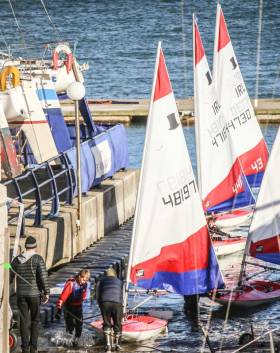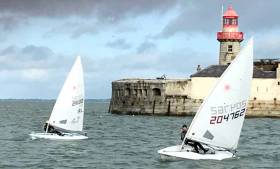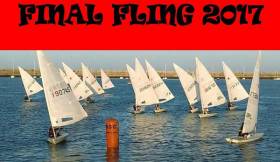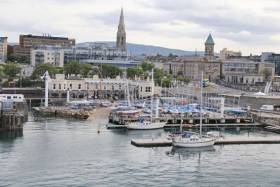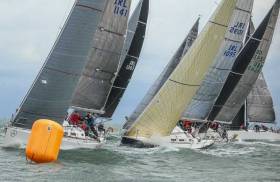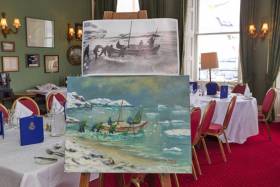Displaying items by tag: RStGYC
Sailing Clubs Benefit in Sports Capital Grants: €1m to 30 Clubs Across the Country
Irish sailing clubs are among 1,700 sports clubs nationwide receiving €56m in the latest round of sports capital grants, it was confirmed this morning. (Download the full list of grants awarded below).
30 sailing clubs throughout the country will share over a million in funding.
Dun Laoghaire's National Yacht Club on Dublin Bay is one of the biggest sailing club recipients with a grant of €142,375 for Increasing women and teenagers participation in the sport. The east pier club is the home of Rio Olympic silver medalist Annalise Murphy.
Also in Dun Laoghaire, the country's bggest sailing centre, the Irish National Sailing Club (Locaste) got €40,058 for the renewal of sailing equipment and the purchase of new boats.
The Royal St. George Yacht Club (RSGYC) got €31,228 for a Firefly dinghy renewal programme, Dun Laoghaire Motor Yacht Club got €18,515 for the purchase of a 5m RIB and capstan winch. The Royal Irish Yacht Club got €25,000 for its safety and support fleet. Dublin Bay Sailing Club got €11,236
In Cork Harbour, Royal Cork Yacht Club were awarded €13,000 for support craft for teaching water sports
The programme is the primary means of providing Government funding for capital projects to sport and community organisations at local, regional and national level.
'This funding will give make a considerable impact on access to sailing in regional clubs, as well as help develop and improve sailing facilities. The pay back is the physical and mental benefits of sailing to local communities, ' according to an Irish Sailing spokesperson.
The 2017 round for applications closed in February with a record number of 2,320 received.
Around the coast – and on lakes and rivers too – sailing clubs shared in the distribution of the captial funds.
In Limerick, Foynes Yacht Club was awarded €16,500 for Physically Disabled Sailing. Sligo Yacht Club got €8,000 for its 'Try A Sail' and 'Inclusion for All' project.
In Tipperary, Lough Derg Yacht Club was awarded €4,000 for its access for all programme.
In Westmeath, Lough Ree Yacht Club got €12,500 to replace destroyed electrics and to buy two boats.
In West Cork, Glandore Harbour Yacht Club has €16,000 for a new clubhouse roof & canopy.
Minister Shane Ross said at the announcement: "This is a great day for Irish sport. When we originally invited applications under the scheme, we had just €30m to allocate and the record level of applications would have left a large number of good projects unsupported and many clubs disappointed.
"Happily, following the conclusion of budget discussions, I was delighted to secure the required additional resources to enable me to allocate €56m in total to local sports clubs and organisations throughout the country.
"The net result of this is that we are able to provide financial assistance towards over 1,700 different projects all over the country.
"The benefits of participating in sport are well documented, for both physical and mental health, and these new grants for local clubs will help us in our overall objective of getting as many people participating in sport as possible.
"The grants are also excellent news for our communities both rural and urban, as club sport is a superb way to bolster local pride, affinity and inclusion."
A further €4m has been set aside for regional grants. These allocations are expected to be announced in the coming weeks.
| Killaloe Sailing Club | Sail Training Dinghies for Children and Teenagers | €6,000 |
| Bantry Bay Sailing Club Bantry Bay Sailing Club | Club Development | €23,000 |
| Bere Island Projects Group Ltd | Bringing Sailing back to Bere Island | €11,000 |
| Glandore Harbour Yacht Club | New clubhouse roof & canopy over adjacent yard | €16,000 |
| Kinsale Yacht Club Company Ltd | Rigid Inflatable boat (RIB) for training & safety | €8,000 |
| Monkstown Bay Sailing Club | Changing rooms renovation & engine upgrade | €8,000 |
| Royal Cork Yacht Club | Support Craft for teaching water sports | €13,000 |
| Schull Harbour sailing Club Ltd S | RIB – Dinghy Sailing & Cruiser Crewing | €18,000 |
| Clontarf Yacht & Boat | Club upgrade facilities for equality of access at CYBC | €136,943 |
| Dublin Bay Sailing Club | Sports Equipment | €11,236 |
| Malahide Yacht Club | Essential Rescue Equipment | €61,200 |
| Poolbeg Yacht and Boat Club | Dublin City Community Sailing | €150,000 |
| Royal Irish Yacht Club | Safety and support fleet | €25,000 |
| Rush Sailing Club | Expansion & Refurb of changing & toilet facilities | €130,381 |
| Sailing in Dublin Club Ltd | Keelboat for racing and training | €20,000 |
| The National Yacht Club | Increasing Women and Teenagers participation | €142,375 |
| The Royal St. George Yacht Club RSGYC | Club Firefly Dinghy Renewal | €31,228 |
| Galway Bay Sailing Club Ltd | RIB Purchase | €14,000 |
| Galway City Sailing Club | Sailing dinghies & Safety Boat for shared sailing | €17,500 |
| Foynes Yacht Club | Sailing in Foynes for Physically Disabled | €16,500 |
| Oriel Sailing Club | Purchase of sailing equipment | €6,000 |
| Mullaghmore Sailing Centre ltd. | Sailing boatsRescue boat engines, Club Refurb. | €11,500 |
| Sligo Yacht Club Ltd | ‘Try A Sail’ and Inclusion for All, Project | €8,000 |
| Lough Derg Yacht Club | School sailing and access4all programme | €4,000 |
| Waterford Harbour Sailing Club | New Rescue/Safety RIBs & Dinghies | €34,000 |
| Lough Ree Yacht Club | Replace Destroyed Electrics. Buy 2 Boats | €12,500 |
| Blessington Sailing Club | Community growth project | €15,000 |
| Bray Sailing Club | Growing sailing in the community | €19,591 |
| Greystones Sailing Club | Development boats | €10,000 |
| Wicklow Sailing Club | Rescue Craft and Storage | €46,000 |
| €1,025,954 |
'Final Fling' is Flung for Dinghy Season at Dun Laoghaire
‘The Final Fling is Flung’ commented one competitor as he painfully dragged his boat up the slipway in Dun Laoghaire. Strong north-easterly’s greeted the fleet on Sunday afternoon.
With a healthy entry of 22 boats, from four different dinghy fleets – the effects of the 'weather bom'b that was Storm Brian caused the postponement of racing by 24 hours. Three races with no discard were held in the Harbour.
In the Feva fleet – Elysia O’Leary and Lilly Dwyer took top spot in the testing conditions.
Laser Standard – Conor O’Leary sailed solidly to take first overall – with the rest of the fleet decimated by gear and body failure!
 Royal St. George's Toby Hudson Fowler, sporting the overall Final Fling prize!
Royal St. George's Toby Hudson Fowler, sporting the overall Final Fling prize!
Laser Radial first overall was decided on the last mark rounding of the last race with young gun Toby Hudson-Fowler getting the better of Dinghy Master Sean ‘Recently Radialised’ Craig. First Female was Shirley Gilmore.
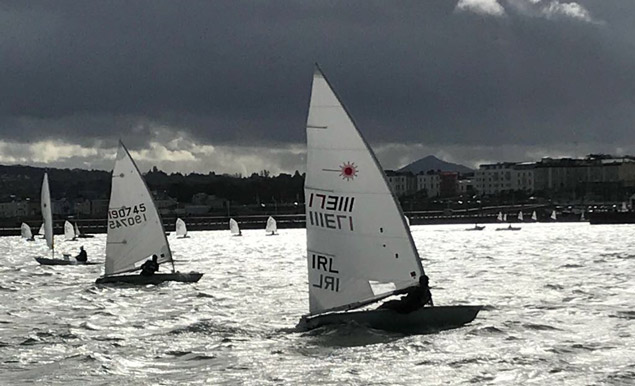
The Waspz fleet wisely stayed at home!
Final Fling 2017 showcased the competitive Dinghy racing is provided by DBSC each Tuesday evening during the summer – Overall regatta winner Toby commented that he will ‘definitely joining in next year and will be dragging along some of his young radial sailor mates’…
If any other Dinghy fleets want to get involved or make Tuesday evening dinghy racing part of their training plans for 2018 please let us know now!
Thanks to RO Michael Tyrell & Crew, DBSC for providing committee and patrol boats and host club Royal St George.
Final Fling 2018 – 29/9/18 – one for the diary!
Results here
Storm Brian 'Weather Bomb' Means Final Fling Postponed
To make way for the weather bomb that is Storm Brian this weekend, the Royal St. George Yacht Club hosted Final Fling 2017 for dinghies has been delayed until Sunday 22nd with first gun at 13.00.
With quick 1-2-3 starts, four sprint races lasting 30 to 35 minutes aim to guarantee some fun, competitive racing.
All fleets welcome. Entry €20 per boat on the day.
An Apres Sail will be held in the Royal St. George Yacht Club.
Online entry still open here
Dragon Sailors Hegarty, Williams & Bowring Capture Irish Title at Royal St. George Yacht Club
Royal St. George Dragon Phantom sailed by Neil Hegarty, David Williams and Peter Bowring were winners of the seven–race Irish Dragon National Championships on Dublin Bay yesterday by two clear points.
The title win follows Hegarty's East Coast championship victory sailed at the same venue a fortnight ago.
The Royal St. George trio fought off a strong challenge from Kinsale's Cameron Good, Simon Furney and Henry Kingston in Little Fella who were runners up on 13 points.
Defending champion, Martin Byrne, who was seeking his fifth title, sailing Jaguar, was third on 20 points in the 11–boat fleet.
Meanwhile, in Cascais, Portugal, Howth Yacht Club's Laura Dillon Jonathan Bourke, Rita Gonçalves and Antonio Gois finished 33rd from 70–boats at the Dragon World Championships.
Andy Beadsworth, Ali Tezdiker and Simon Fry won the World Dragon title in the final and only race of the day.
Overnight the Russian team Annapurna skippered by Anatoly Loginov were given redress by the race committee for a collision on the penultimate days racing which caused them to retire from that race. Their redress score re-duced the gap to 7 points from the Turkish flagged boat overnight with Lawrie Smith (Alfie) another 2 points adrift.
The final race of the regatta started on time at 1305 hrs local time on yet an-other steamy hot day on the Guia race course off the coast of Cascais. The breeze from the N/NW was lighter than most of the week at around 10 - 12 knots at the start, up to 15 kts at the top of the course.
NED412 took the race bullet by a comfortable margin to move up to 6th in the overall rankings and RUS76 (Rocknrolla) Dmitry Samokhin improving all week to finish clear in 2nd. GBR803 (Gorgeous Worgeous) Quentin Srauss, sailing in the Masters category, just snatched third on the finish line in his best result of the regatta.
In fourth, also a regatta best was JPN50 (Yevis ll) with Bocci Aoyama at the helm. Fifth was a very popular result for the Portuguese as Patrick Monteiro de Barros declared this race his regatta his last with his intended retirement.
Lawrie Smith (Alfie) with his Portuguese crew, Hugo Rocha, Joao Matos Ro-sa and Goncalo Ribeiro crossed 7th to confirm third place in the overall podium. Anatoly Loginov in Annapurna had to count a 17th but held on to second overall. -- Jonny Fullerton
Overall World Results: (Top 10 of 70 boats after 8 races with 1 discard)
1. Provezza Dragon, Andy Beadsworth, TUR, 32 points
2. Annapurna, Anatoly Loginov, RUS, 36.2
3. Alfie, Lawrie Smith, GBR, 38
4. Desert Eagle, Hendrik Witzmann, UAE, 55
5. Rocknrolla, Dmitry Samokhin, RUS, 64
6. Troika, Pieter Heerema, NED, 65
7. Bunker Prince, Braslavets Yevgen, UAE, 65
8. Drago, Jose SM Matoso, POR, 68
9. Louise, Grand Gordon, GBR, 88
10. Jeanie, Jens Rathsack, MON, 88
2017 Irish Dragon National Championships Results
1st Phantom 176 RSGYC Neil Hegarty David Williams Peter Bowring 1.0 1.0 2.0 4.0 1.0 2.0 (5.0) 16.0 11.0
2nd Little Fella 211 KYC Cameron Good Simon Furney Henry Kingston 3.0 3.0 1.0 1.0 (5.0) 3.0 2.0 18.0 13.0
3rd Jaguar IRL216 RSGYC Martin Byrne Brian Mathews John Simms 4.0 2.0 (8.0) 3.0 2.0 1.0 8.0 28.0 20.0
4th Whisper 206 RSGYC Clare Hogan C Murphy R Murphy (8.0) 4.0 7.0 6.0 3.0 4.0 3.0 35.0 27.0
5th Basilisk D GBR 515 AYC Patrick Gifford Fiona Gray Kevin Hayes 6.0 5.0 6.0 (12.0 RET) 8.0 5.0 1.0 43.0 31.0
6th Serafina 180 KYC Daniel Murphy Brian Goggin Harvey Tucker (7.0) 7.0 4.0 2.0 7.0 6.0 7.0 40.0 33.0
7th D-cision IR 195 RSGYC/ RIYC Chris Fleming Joey Mason Eddie Tingle 2.0 6.0 3.0 5.0 (9.0) 9.0 9.0 43.0 34.0
8th Zu 214 RStGYC Mark Bolger Charlie Bolger Conor Grimley (12.0 RET) 9.0 5.0 7.0 6.0 7.0 4.0 50.0 38.0
9th Aphrodite IRL 110 GHYC John Wyles Peter Hayes Michelle Hayes (12.0 DNF) 8.0 10.0 8.0 4.0 10.0 6.0 58.0 46.0
10th Grey Hare 187 KYC Shawn Kingston Antony O’Neill Tony Kingston 5.0 10.0 9.0 (12.0 RET) 10.0 8.0 10.0 64.0 52.0
11th Magic IRL 695 GHYC Eamon Timony Diarmaid O’Sullivan William Barry (alternate) (12.0 DNF) 12.0 RET 12.0 DNC 12.0 DNC 12.0 DNC 12.0 DNC 12.0 DNC 84.0 72.0
Dun Laoghaire Sailability Programme Returns For 2017
#Sailability - Dun Laoghaire’s waterfront clubs have launched their 2017 sailability programme for children ages 8-17 with physical and/or sensorial disabilities.
The programme kicks off with a try sailing event on Sunday 11 June at the Royal Irish Yacht Club, with morning sailing proper commencing at the Royal St George on Sunday 18 June, continuing each week (except 9 July and 6 August) till 20 August in conjunction with the Dun Laoghaire Motor Yacht Club.
There will also be two week-long sailing courses, provided by the National Yacht Club (12-16 June) and the Royal Irish YC (8-11 August).
No sailing experience is necessary to take part in the sailability programme, sponsored in 2017 by the Spirit Motor Group Volvo Ireland and the Water Wag sailing class, among others.
For general enquiries and further details, contact Ian French (087 245 6834 or [email protected]) or
Ruth Shanahan (086 237 4801 or [email protected]).
Family Fun Day At Royal St George Yacht Club This Sunday
#RStGYC - All are invited to the Royal St George Yacht Club’s family fun day this Sunday 14 May — both on the water and cheering on the fleet from the Dun Laoghaire waterfront.
The action kicks off from 1pm with a pursuit course heading around Dalkey Island, and concludes with a BBQ at the clubhouse at 4.30pm.
Entry is just €5 per boat via the RStGYC website, which has the running order of the day, sailing instructions and the communication sheet for participating sailors.
Irish Youth Sailing's Selection Process is a Serious Business
Its full title is the Irish Sailing Association Youth Pathway Nationals and Optimist Trials. It is a designation with a great air of seriousness about it, contrasting markedly with current public debate about providing more fun sailing, while making regattas as much about sport and enjoyment afloat and ashore as they are about winning.
Yet from time to time, sailing does have to be serious – deadly serious – if we’re going to have any more significant international medals such as those won at the Olympics by Annalise Murphy, at the Laser Radials Worlds by Ewan McMahon,, and at the ISAF Youth Worlds by Doug Elmes and Colin O’Sullivan. The way those great achievements - hard won through a very serious training and participation programme - were able to immediately lift the public mood with their clearcut international success deserves full recognition. W M Nixon tries to put it into perspective for those whose own sailing does not aspire to the giddy international heights.
When you look at that title of “Youth Pathway Nationals and Optimist Trials”, you wonder that as many as 190 boats in six different classes have turned up at Ballyholme for the four days of racing. For there’d been a certain collective madness beforehand, with some folk talking of beyond 200 or even up to 250 boats. But that could be put down to an excess of exuberance following the impressive turnout of 125 Lasers for the Munster at Baltimore.
 On a tight spinnaker reach in Ballyholme Bay, McDowell and Gallagher narrowly lead the 420s from Heather Spain and iseult Kneafsey of the National, with Lucy Kane and Grace Jennings (East Antrim) next in line. Photo: Mark Mackey
On a tight spinnaker reach in Ballyholme Bay, McDowell and Gallagher narrowly lead the 420s from Heather Spain and iseult Kneafsey of the National, with Lucy Kane and Grace Jennings (East Antrim) next in line. Photo: Mark Mackey
For that was - for many - a fun event in a fun place, with a fun fleet except for maybe the top ten - and even they were frequently seen to laugh. And for sure, there are kids who are having a ball at Ballyholme right now. But for just this one long weekend of the year, there are serious moves being made which will decide the development of junior sailing at the top level in the year ahead, and in many of the years beyond that. We should be worried if it weren’t so brutally focused, rather than being unduly concerned about junior sailing becoming too serious.
That said, the seriousness produces its lighter moments, though you could sympathise with the Topper person who noted that there are five Topper places up for grabs for admission to the Topper Pathway Scheme, yet there are 32 Toppers (39 including the 4.2s) racing their little hearts out at Ballyholme. “What are we going to say?” asked this conscience of the Topper class, “What are we going to say to the young skippers who come 6th, 7th and 8th.....?”
Then there was the Optimist dad who arrived into the Race Office letting the world know that his family’s budget for the event was already shot to ribbons. Heaven only knows what the accommodation pressure would have been like if the more optimistically anticipated fleet of 250 boats with all classes had all turned up. For as it is, accommodation pressures have resulted in people being forced to rent houses for the week – for there’s no way you can get a rental starting on a Wednesday night – and deciding that the sensible thing is to come for a week’s holiday for the whole family. Inevitably, it means lots of money running out the door before the one or two family members who are actually racing start their proper sailing.
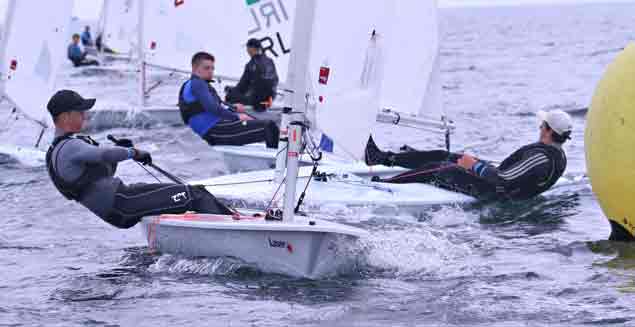 After two days Ewan MacMahon of Howth has the overall lead in the Laser Radials. Photo Mark Mackey
After two days Ewan MacMahon of Howth has the overall lead in the Laser Radials. Photo Mark Mackey
So anyway this Opty dad is telling anyone who is listening that the budget is already shot with the family spending a whole week in a house in a village he’d never heard of before. But now, worse still, somebody has just told him that his daughter is seen as one of the rising stars of the class, and they wouldn’t be surprised, once this weekend’s racing is finished, to see her name down as a potential member for the Irish squad at the Optimist Worlds 2017 at the Royal Varuna Yacht Club in Thailand in July.
“And do you know what that means?” he demands. “It means that if we accept that offer of a place at the Worlds, within a week we have to divvy up €2,000 for the International Optimist Dinghy Association of Ireland. I can tell you something” he continues, now in full flight, “if she’s anywhere within range of a place with only one or two races still to go, we’ll be seriously thinking of feeding her a dodgy chicken sandwich.....”
Such are the joys of being an Opty dad. And it was something to contemplate along with the fondest recollections at an event on Thursday night in my own home club of Howth, when friends from times past – some of them friends from very long times past – joined with the great and the good including ISA President Jack Roy and his wife Rosemary, and HYC Commodore Joe McPeake – together with a whole raft of former HYC Commodores – to celebrate the award by World Sailing (formerly ISAF) of a Gold Medal to Howth’s own Helen-Mary Wilkes for her decades of service to the International Optimist Dinghy Association worldwide.
 At the conferring of Honorary Membership of Howth Yacht Club on Helen-Mary Wilkes in celebration of her Gold Medal from World Sailing are (left to right) Jack Roy (President, Irish Sailing Association), Joe McPeake (Commodore Howth YC, who is holding a copy of Robert Wilkes’ History of the International Optimist Class,) Helen-Mary Wilkes, and Robert Wilkes. Photo: John Deane
At the conferring of Honorary Membership of Howth Yacht Club on Helen-Mary Wilkes in celebration of her Gold Medal from World Sailing are (left to right) Jack Roy (President, Irish Sailing Association), Joe McPeake (Commodore Howth YC, who is holding a copy of Robert Wilkes’ History of the International Optimist Class,) Helen-Mary Wilkes, and Robert Wilkes. Photo: John Deane
Her international career started when it was noted that she was the key player as Secretary of the Organising Committee when Howth ran the Optimist Worlds in 1981. After that, Helen-Mary’s international service was of such quality and duration that her most recent years with the IODA have been as President of Honour. For, in the many years she was actually running it all on a day-to-day basis with the backroom support of her husband Robert, they saw an increase of 78% in international membership of the world association to bring the total to 87 countries, and 57 of those countries regularly took part in international championships, while boat numbers increased stratospherically.
It was by no means an easy ride, for with main builders in several countries and different continents, the Optimists were by no means totally One-Design. But fortunately Helen-Mary Wilkes had the very man in Ireland with the skill, patience and diplomacy to sort this out - David Harte of Schull, at that time a Howth resident. As an Optimist builder himself, “Harty” knew everything about these very important little boats, and between 1995 and 1997 he was on an almost continuous worldwide mission to persuade the eight main builders to standardise the class to the highest One-Design requirements, an objective in which he succeeded.
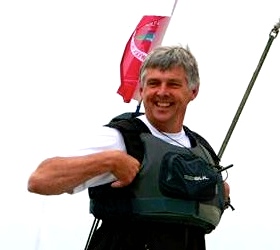 David Harte of Schull, who in 1995 -1997 was instrumental in ensuring that the eight production builders worldwide of the International Optimist Dinghy were producing a truly One-Design boat.
David Harte of Schull, who in 1995 -1997 was instrumental in ensuring that the eight production builders worldwide of the International Optimist Dinghy were producing a truly One-Design boat.
David Harte being one of these people who seems ageless, it takes a bit of an effort to realize that he was doing this all of twenty years ago. But the result has been a much more total global acceptance of the Optimist. And in speaking to Thursday night’s gathering, Helen-Mary and Robert Wilkes addressed people’s concerns that the current event in Ballyholme, and other major Optimist championships in Ireland, are becoming too serious for the good of the young sailors.
“We’re every bit as interested in the kids who are into Optimists just for club racing and local sailing as we are for the high flyers. Over Easter, there are five major Optimist regattas under way at different venues in Europe. In all, more then 4,500 Optimists are sailing at every possible level of competition in these events. Yet at none of those regattas is selection for special strands of training under way. Ultimately, it is all about sailing for sailing’s sake. It only happens to be the case that it’s in Ireland the Easter Regatta is also being used for the trials. Inevitably, there’s criticism that the kids are being put under too much pressure here. But as a matter of policy, the International Optimist Dinghy Association is as interested in friendly local racing as it is in international competition”.
 “Get ’em up and move ’em out....” Optimists and Lasers swing into the launch sequence at Ballyholme. Photo: Pierce Purcell Jnr
“Get ’em up and move ’em out....” Optimists and Lasers swing into the launch sequence at Ballyholme. Photo: Pierce Purcell Jnr
Meanwhile last night up at Ballyholme they were able to post two days of good racing results in westerly winds for the Laser Radials, 420s and Optimists, and one day of racing for the Toppers, Laser 4.7s and Topper 4.2s.
LASER RADIALS
After a 7th, 4th and 6th on Thursday, when Aaron Rogers of Rush SC was the overnight leader, Ewan MacMahon of Howth came back like a rocket yesterday and posted 1,1, and 2nd to leave him leadng on 14pts to the 20 of Henry Higgins of the Royal St George in second (4,(26) 2,4,2,8), with Johnny Durcan of Royal Cork finishing strongly with a bullet in yesterday’s concluding race for a scoreline of 2,8,10, (42 BFD) 3, 1 and a points total of 24. Rush SC pair of Conor Quinn and Aaron Rogers are next on 27 and 28 in a fleet of 43.
420
Geoff Power and James McCann of Dunmore East have recovered from an OCS yesterday to take over the lead in a healthy fleet of 16, they have totalled 6 points with a used scoreline of 2,1,1,1,1, with Gemma McDowell and Emma Gallagher of Malahide taking one of the two spare wins after the Power display of, well, power, the Malahide crew now lie second on 12 points, just one point ahead of the other race winners, Kate Lyttle and Niamh Henry of Royal St George.
OPTIMISTS
Justin Lucas (13) of Tralee and Royal Cork had been hotly tipped as the favourite for the Optimists, and he has certainly lived up to the billing with a scoreline of 1,1,(12),11,4,5,1 after two days of racing in a 62-strong fleet. There has been some post-racing re-arrangement of results with protest outcomes, but Lucas is well clear of Royal Cork’s Michael Carroll with 23 points to the 37 of Carroll in second, while James Dwyer Matthews (Cork & Kinsale) is tied on 40 with the leading junior Luke Turvey (Howth and National,) who goes to fourth on the higher discard. Leah Ricard of the National is top girl at 9th overall.
LASER 4.7
The National YC’s Clare Gorman leads after the first day of racing for the 4.7s, with a scoreline of 4,2, and 1 to give 7 pts against the 9 of Royal St George’s Jack Fahey in second, third slot being held by David Carroll of Kinsale & Crosshaven while Tom Higgins of RStGYC and Eva MacMahon of Howth tie on 16, but Higgins takes 4th on the discard in a fleet of 33.
TOPPER
Rob Keal of Royal Cork had a good first day of it yesterday to lodge two firsts and a fourth, giving him 6pts against the 11 of second placed Kate Fahy (RStGYC & Lough Derg) while East Down’s Sarah Jennings’ 13pts keeps her in third ahead of Royal Cork’s Conor Horgan on fourth in a fleet of 32.
TOPPER 4.2
Lewis Thompson of Ballyholme and Donaghadee has had three straight firsts to the three seconds of Ballyholme’s Hannah Dadley-Young, third overall is Donaghadee/Ballyholme’s Joshua McGregor with two hirds and a fourth while Adam Irvin of the Irish National Sailing School is fourth on 4,5,4.
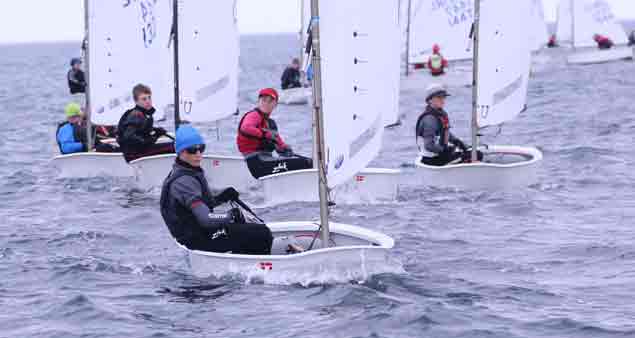 Justin Lucas of Tralee Bay is leading the 62-strong Optimist fleet. Photo: Mark Mackey
Justin Lucas of Tralee Bay is leading the 62-strong Optimist fleet. Photo: Mark Mackey
It is interesting to contemplate all this highly-regulated contemporary modern sailing on Belfast Lough, for it was far from Lasers and 420s and four days of intensive racing from committee boat starts that we were reared when we spent our first years afloat in and around Ballyholme Bay.
In those days, proper junior training and a structured junior racing programme weren’t so much in their infancy as barely a gleam in anyone’s eye. At a certain age – before any of us was even into our teens – we were given a new 14ft clinker sailing dinghy of the Ballyholme Insect Class, and told to get on with it on the assumption that, having sailed with adults in keelboats, we’d know how it was done.
 Steep learning curve. We weren’t even into our teens when we were presented with a 14ft Ballyholme Insect Class, and told to get on with it. Photo: W M Nixon
Steep learning curve. We weren’t even into our teens when we were presented with a 14ft Ballyholme Insect Class, and told to get on with it. Photo: W M Nixon
With a massive lack of imagination, we called her Grasshopper. In truth, Rockhopper would have been more on target. The distinctly exposed Ballyholme Bay is sheltered to the northeast, ’tis said, by Ailsa Craig, which is 40 miles away. Admittedly the bay has a decidedly featureless shoreline at low water, which limits sailing options even if you aren’t hampered by strong onshore winds. But when the tide is well in, all sorts of little islands and channels are created, and we learnt our sailing threading our way through this miniature maze of skerries.
 Ballyholme Bay at Low Water has a rather featureless shoreline....
Ballyholme Bay at Low Water has a rather featureless shoreline....
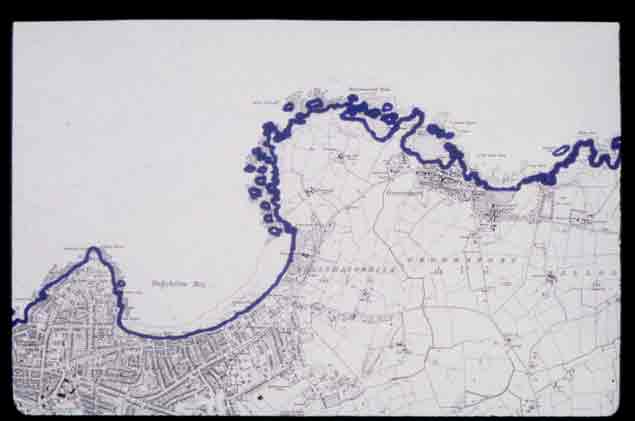 ....but at High Water it becomes a much more interesting place, with all sorts of islands and channels.........
....but at High Water it becomes a much more interesting place, with all sorts of islands and channels.........
 ......through which a sailing dinghy with centreplate half-raised can thread her way. Photo: W M Nixon
......through which a sailing dinghy with centreplate half-raised can thread her way. Photo: W M Nixon
There was of course no such thing as an accompanying rescue boat, but from time to time we sailed in consort with a friend whose boat was a smaller sister, a 12ft–clinker dinghy, but made more exotic with a little bowsprit.
Safety rules were few. We were expected to wear kapok lifejackets when actually sailing, but not otherwise, and they’d immediately be used as fenders if we came alongside rocks or small jetties. As for sailing limits, we were supposed to stay in Ballyholme Bay south of a line from Luke’s Point on the west side over to a rock called Jenny’s Isle off Ballymacormick Point to the northeast. However, at high water you could sail with the centreplate half up inside Jenny’s Isle and the tidal islets beyond it, so you could keep going east, while staying within that outer limit line, until you’d gone clean round the world.
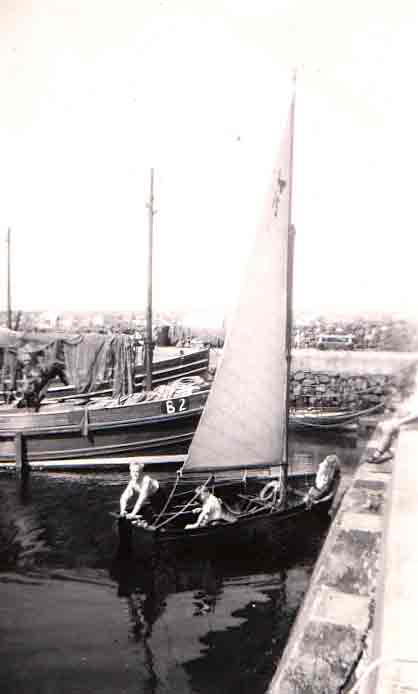 Groomsport, a little fishing harbour which was our first “foreign port.” It is less than two miles from the anchorage at Ballyholme Bay Photo: W M Nixon
Groomsport, a little fishing harbour which was our first “foreign port.” It is less than two miles from the anchorage at Ballyholme Bay Photo: W M Nixon
But there wasn’t that much mischief in us, so it was quite a day when official permission was given to sail all the way to the nearby fishing harbour of Groomsport, our very first Foreign Port of Call. And after that, the south shore of Belfast Lough from Orlock Point to Grey Point was our cruising paradise, and we’d disappear off for the entire day with a basic lunchbox and the hope of augmenting it with mackerel.
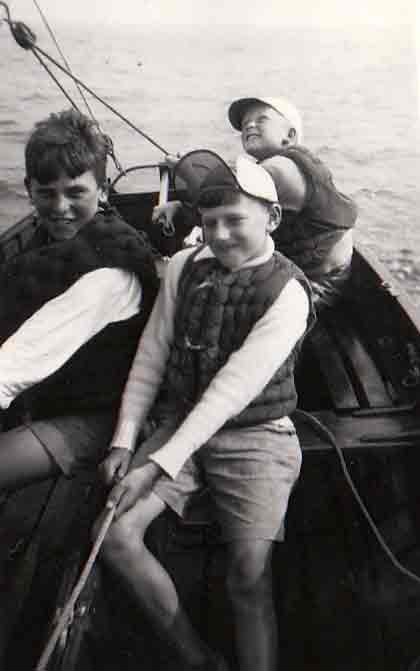 Off for a days cruising, with a lightly packed lunchbox and a couple of mackerel lines to augment the meal. Photo: W M Nixo
Off for a days cruising, with a lightly packed lunchbox and a couple of mackerel lines to augment the meal. Photo: W M Nixo
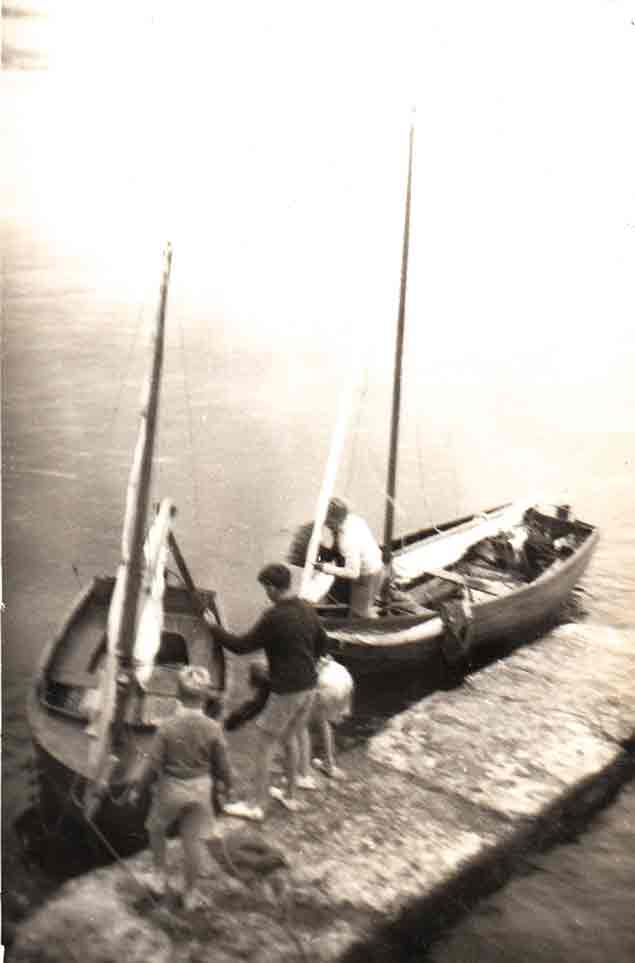 Cruise in company. The fleet gathers at Swinley Bay three miles west of Ballyholme, and lifejackets soon become fenders. Photo W M Nixon
Cruise in company. The fleet gathers at Swinley Bay three miles west of Ballyholme, and lifejackets soon become fenders. Photo W M Nixon
If the wind fell light in the evening, we could row home, and over the years nobody gave our daylong absences any thought. There were some close calls, but we never actually capsized the boat. Which was just as well, for if you capsized an Insect, she stayed capsized, and you were barred for a week from Ballyholme Yacht Club for what was deemed reckless and unseamanlike behavior.
That was how you learned to sail back in the day. Eventually it was reckoned we knew enough to be reasonably harmless to others if we went racing with what was then Ballyholme’s only dinghy class. A long way indeed from the hotshot dinghies of today, and their accompanying coaches in their RIBs.
For the summer of 2017 at least, it looks as though Dun Laoghaire Harbour is going to remain free of the threat of the installation of a new liner berth. W M Nixon reckons this provides a unique opportunity for town and harbour to come together as they may have done once upon a time, but have failed to replicate for many years. He provides the background, and makes some suggestions.
The trouble with Dun Laoghaire is that there’s nowhere else quite like it. There isn’t really a truly comparable totally artificial harbour anywhere else on this scale set on the edge of a city, in the midst of an area of general affluence and recreational expectations. It is arguably unique. Nowhere in the world is there a similar setup from which those who hope to manage Dun Laoghaire Harbour effectively might learn lessons on how to make a viable proposition of their port and its future.
Although the original asylum harbour was built by engineer John Rennie and others in majestic style, at the time it had only one simple purpose – to provide shelter for unwieldy sailing ships when Dublin Bay was storm-beset and Dublin Port with its very shallow bar entrance was inaccessible.
The original plans show a sublime indifference to the existence of the little old harbour of Dunleary immediately to the west of the proposed location of the vast new structure. And the little port there has long since disappeared under high value property development to an extent which the early harbour planners cannot have begun to imagine.
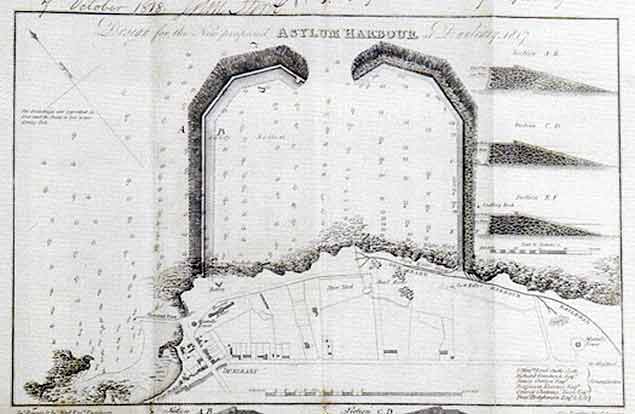 The original plan for the new harbour deliberately excluded the little old harbour of Dunleary to the west, as the new harbour was not intended to provide ship to shore access.
The original plan for the new harbour deliberately excluded the little old harbour of Dunleary to the west, as the new harbour was not intended to provide ship to shore access.
For the idea was not that this would be a port. On the contrary, it would only be a place of temporary shelter in which vessels of importance – particularly those on British government business - would be secure until conditions improved. It was not envisaged that there would be any significant shoreside contact during their short time in what very quickly became Kingstown Harbour.
For of course, no sooner was a harbour under construction, than a town began to develop beside it. It was notoriously un-planned, so much so that fifty years later a critic mocked its name of Kingstown – conferred with a Royal visit in 1821 – by pointing out that far from being a King’s town, it was rather more of a republic of selfish building anarchy.
At the beginning – which we now date to 200 years ago, with the first stone officially laid on May 31st 1817 - significant shoreside development had not been intended. As historian Hal Sisk has pointed out, at no time did the official plans include anything so basic to a proper port town such as warehouses, let alone shipyards or even boatyards. But the basic existence of the harbour in its earliest form by the late 1820s saw the first regatta being staged in 1828. Recreational sailing and the harbour have been intertwined ever since. And the irresistible growth impulse of Kingstown was underlined by the arrival of the railway from Dublin in 1834.
 The eastern part of Kingstown harbour at its Victorian high point as a ferry port. The area in the centre, immediately east of Carlisle Pier, will be used for berthing Classic and Traditional Vessels in July during the Volvo Dun Laoghaire Regatta 2017.
The eastern part of Kingstown harbour at its Victorian high point as a ferry port. The area in the centre, immediately east of Carlisle Pier, will be used for berthing Classic and Traditional Vessels in July during the Volvo Dun Laoghaire Regatta 2017.
We take that date of 1834 for granted, but in terms of world railway history, it was very early indeed. And it in turn roped Kingstown into other unplanned developments. As long as the entrance to Dublin port remained dangerously shallow, Kingstown had all the advantages for the rapid development of the cross channel ferry trade. It was all done initially on an ad hoc basis, but it worked for the ferries, while the already proven attractions of the place as an innovative recreational sailing location made it central to world sailing development by the 1860s and 1870s.
So for most of the two hundred years whose history we’ll be celebrating in July, Dun Laoghaire/Kingtown has been struggling with the fact that the basic concept of the harbour - which by its monumental and historic scale still dictates what can be done with it today – was planned with virtually no attention paid to the sea/land interface.
 Despite the restrictions on waterfront space, Kingstown Harbour had become a leading sailing centre by the latter half of the 19th century, as shown in this painting by Richard Brydges Beechey of a Royal St George YC regatta in the 1870s. Courtesy RStGYC
Despite the restrictions on waterfront space, Kingstown Harbour had become a leading sailing centre by the latter half of the 19th century, as shown in this painting by Richard Brydges Beechey of a Royal St George YC regatta in the 1870s. Courtesy RStGYC
Ideally, when the harbour was being built, at least as large an area ashore should have been set aside on the adjacent land to provide for a proper harbour town. But nothing remotely like this was done, and the railway was brought in by the easiest possible shoreside route, thereby putting another barrier between the growing town and the harbor. As a result, the town/harbour relationship has always been problematic. This is particularly so when allied to the fact that areas of conspicuous affluence are almost cheek by jowl with what seem like semi-deprived areas by comparison.
On top of all this, there’s the eternal problem of paying for the harbour’s maintenance. It was superbly built in the first place, but it would be an insult to those early engineers, and their incredibly industrious workers labouring under dangerous conditions, if we failed to maintain the harbour properly in a manner which respects its original concept, while continuing to give it validity for contemporary life.
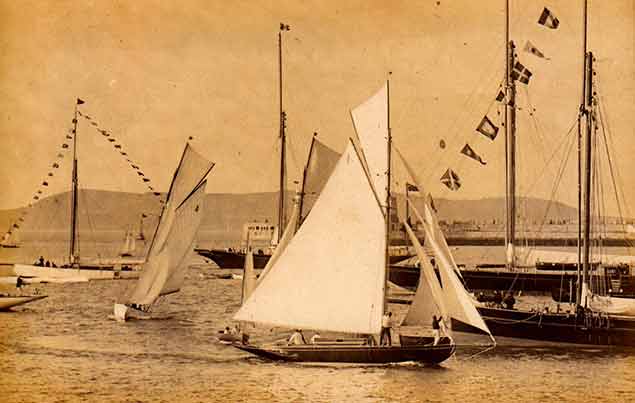 The good old days……..It is the summer of 1901, and the Viceroy Lord Dudley is finishing in-harbour after threading his course through moored yachts to take the win with his new Dublin Bay 25 Fodhla in company with some boats of the new version of the Water Wag class. In second place in the DB 25s is Nepenthe (No 4, Sir H Robinson). Both Dublin Bay 25s were built in Dun Laoghaire by J E Doyle. Photo courtesy Theo Harris
The good old days……..It is the summer of 1901, and the Viceroy Lord Dudley is finishing in-harbour after threading his course through moored yachts to take the win with his new Dublin Bay 25 Fodhla in company with some boats of the new version of the Water Wag class. In second place in the DB 25s is Nepenthe (No 4, Sir H Robinson). Both Dublin Bay 25s were built in Dun Laoghaire by J E Doyle. Photo courtesy Theo Harris
Since the ferries pulled out to re-locate entirely in Dublin Port, taking their guaranteed income stream with them, the struggle has gone on between those who wish to develop any potential the harbour might have for a cruise-liner port of call, and those who feel it should be seen more as a sort of maritime version of the Phoenix Park. They envisage it as a vast breathing space, ultimately maintained by public funds if there’s a shortfall between the income generated by recreational use, and the routine maintenance and administration expenses.
But for the moment, any further development has been postponed awaiting a court case. In it, the point is to be made that making the harbour accessible to functioning liners, with emission-spewing machinery working on a 24/7 basis, will have the effect of polluting the atmosphere in and around the harbour - particularly along the East Pier, the regular promenade for thousands of Dubliners in search of fresh air.
Apparently this point had not been made in the original hearings, so the result is that for the summer of 2017, Dun Laoghaire Harbour will continue as it is at present, with new areas of open sailing space available following the removal of the Stena installations.
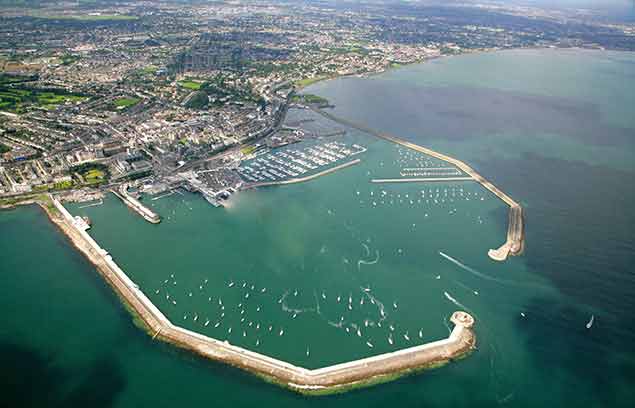 Dun Laoghaire Harbour as it is at present, offering ample space for finishing races. Photo Peter Barrow
Dun Laoghaire Harbour as it is at present, offering ample space for finishing races. Photo Peter Barrow
In the circumstances, surely this is a golden opportunity for the organisers of the Volvo Dun Laoghaire Regatta 2017 to take a look at any section of their enormous and very varied entry list, and select classes which could be given the treat of having at least one of their races finish within the harbour?
Increased ferry traffic was just one of the reasons why the racing for larger craft was obliged to take place outside the harbour. For national and international events, the obsession with committee boat starts and finishes further dictated the move seaward. In Dun Laoghaire, it meant that the connection between the town and active highly-visible sailing became more tenuous than ever.
Yet if we look back to old photos of Dun Laoghaire when it was in the full pomp of its years of Kingstown yachting glory, it was the action in the harbour which brought the whole show to life, and gave everyone a sense of involvement. So let’s hope that the powers-that-be realize that the deferring – permanently we hope – of the proposed liner berth offers an opportunity. Liners Out, Sailboats Back In – that could be the slogan for 2017.
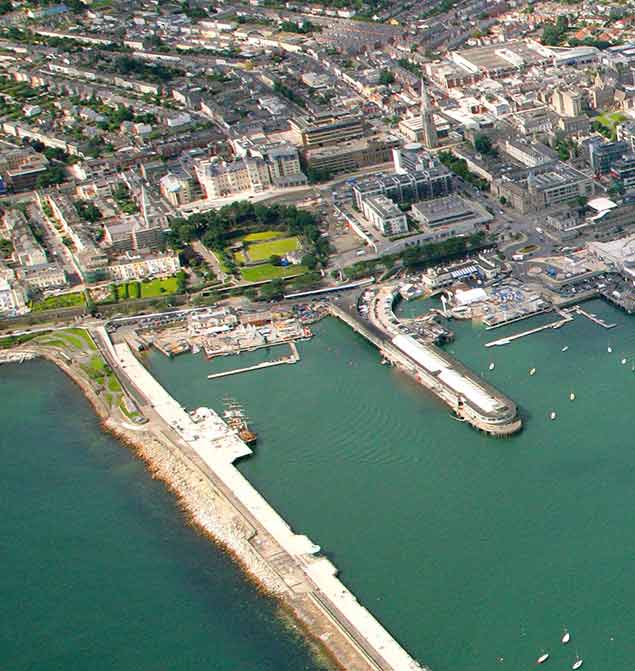 The accessible area off the National YC (photo pre-Lexicon) will provide berthing for Classics and Traditional craft Photo: Peter Barrow
The accessible area off the National YC (photo pre-Lexicon) will provide berthing for Classics and Traditional craft Photo: Peter Barrow
Of course we don’t expect that the really hot classes will agree to finish in-harbour. But there’s something about the Volvo Dun Laoghaire Regatta which attracts a significant segment of participants for whom a bit of fun is central to the sport, and indeed there are many who think that the real sport would be in having to make an in-harbour finish.
The Classics and Traditional Craft will be playing a significant role in this special year. In addition to a dedicated berth with lots of pontoon length being provided for them in the area off the National Yacht Club, the word is that on one day at least, they will have their start in the harbour, highly visible from the East Pier in the area immediately beyond the Carlisle Pier.
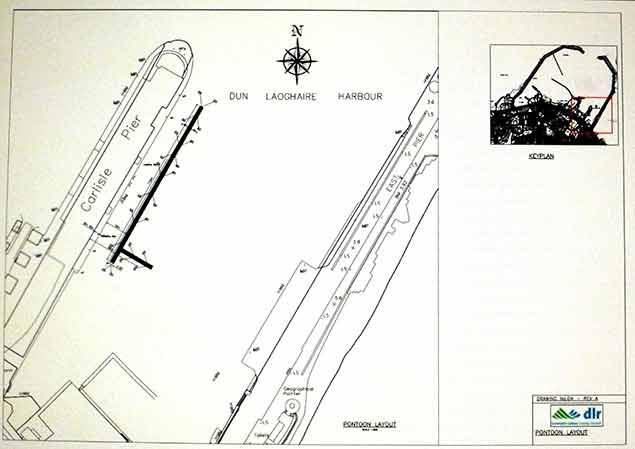 Plan of the proposed pontoon location off the National YC to berth “boats with bowsprits”.
Plan of the proposed pontoon location off the National YC to berth “boats with bowsprits”.
With boat types such as Drascombes coming as a fleet, the notion of the potential accessibility of sailing could be given an enormous boost. What could seem more approachable than the presence of Drascombe man Jack O’Keefe and his mates in friendly competition within the harbour, along with all sorts of other exotic craft such as the Shannon One Designs?
 Jack O’Keeffe’s Drascombe is usually seen in distant ports of the west… .Photo: Pierce Purcell
Jack O’Keeffe’s Drascombe is usually seen in distant ports of the west… .Photo: Pierce Purcell
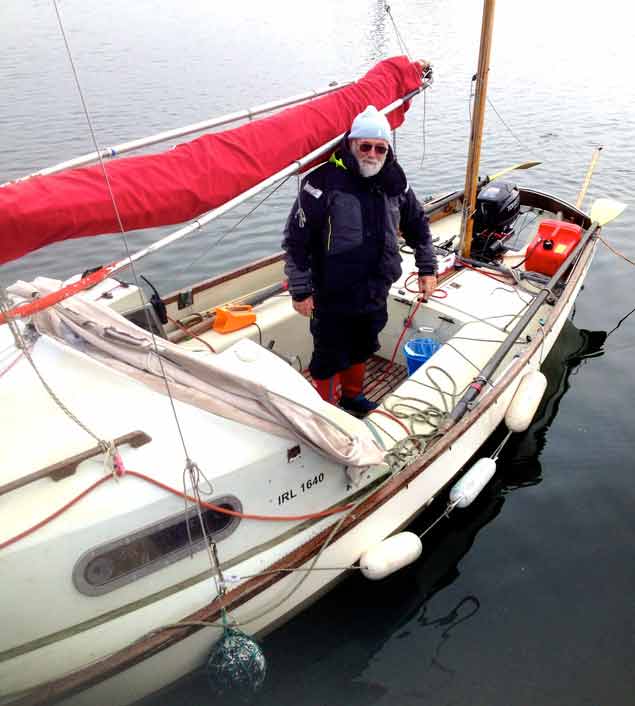 ….but in July 2017 he and his fellow enthusiasts are headed for Dun Laoghaire’s Bicentenary. Photo: Pierce PurcellNot least of such exotica will be the Water Wags, more than ever a part of Dun Laoghaire sailing and Dun Laoghaire Harbour. At this week’s launching of Volvo Dun Laoghaire Regatta ing of Volvo Dun Laoghaire Regatta 2017 in the National Maritime Museum, there was something very touching about the way that the only surviving boat of the original Water Wag class of 1887, the world’s first One Design, had been moved to the centre of the former Mariners Church. The little boat was there in pride of place as the great and the good of Irish sailing networked with each other as plans were revealed of the remarkable amount of behind-the-scenes work that goes into ensuring that this largest of all Irish sailing events runs smoothly.
….but in July 2017 he and his fellow enthusiasts are headed for Dun Laoghaire’s Bicentenary. Photo: Pierce PurcellNot least of such exotica will be the Water Wags, more than ever a part of Dun Laoghaire sailing and Dun Laoghaire Harbour. At this week’s launching of Volvo Dun Laoghaire Regatta ing of Volvo Dun Laoghaire Regatta 2017 in the National Maritime Museum, there was something very touching about the way that the only surviving boat of the original Water Wag class of 1887, the world’s first One Design, had been moved to the centre of the former Mariners Church. The little boat was there in pride of place as the great and the good of Irish sailing networked with each other as plans were revealed of the remarkable amount of behind-the-scenes work that goes into ensuring that this largest of all Irish sailing events runs smoothly.
In the 1890s, there must more than a hundred of these little boats in and around the Greater Dublin area. Even Erskine Childers, with part of the summer of 1894 unfilled in his plans, arranged to have one carted up into the Wicklow Hills to the mountain lake of Lough Dan near the house of his mother’s family, so that he could go sailing when the mood took him.
Yet with the new larger boats introduced in 1900, the little old double-enders just faded away. Fortunately, someone noticed that an odd-looking little canoe-sterned dinghy with a centreplate case on the beach at Malahide was one of the original Water Wags. She was being used for the occasional fishing trip, and it had been a long time since the centreplate had been used for sailing.
She was saved in the nick of time, and is now kept fully rigged in the Maritime Museum. But as the Wag Class historian Vincent Delany assured me at the Volvo reception, she really is absolutely the only surviving original example of a boat which was once so numerous, and fundamental to the global development of sailing.
 The original Water Wags of 1887, the world’s first One Design class. Despite being numerous in the 1890s, the original boat on display in the National Maritime Museum in Dun Laoghaire is now thought to be the only survivor of this historic type.
The original Water Wags of 1887, the world’s first One Design class. Despite being numerous in the 1890s, the original boat on display in the National Maritime Museum in Dun Laoghaire is now thought to be the only survivor of this historic type.
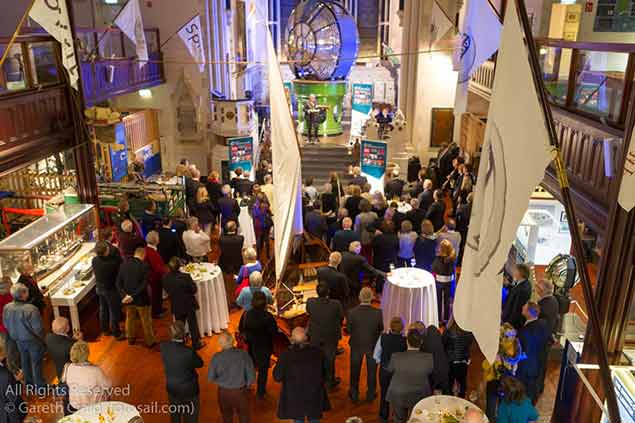 At the heart of things. The sole surviving Dublin Bay Water Wag of 1887 in the midst of the Volvo Dun Laoghaire Regatta 2017 launch reception in the National Maritime Museum on Wednesday night.
At the heart of things. The sole surviving Dublin Bay Water Wag of 1887 in the midst of the Volvo Dun Laoghaire Regatta 2017 launch reception in the National Maritime Museum on Wednesday night.
#RStGYC - The Royal St George Yacht Club hosted a special presentation of a painting to mark the 100th anniversary of Shackleton's voyage on the James Caird from the South Shetlands to South Georgia.
Painted by Jim Sweeney from Frank Hurley's original photograph, 'Launching the James Caird from the shore of Elephant Island, 24 April 1916' recognises the centenary of the desperate 800-mile search for help across Antarctic waters by a crew that included in its number fellow Irish explorer Tom Crean.
The presentation followed a reception in March at the British Embassy to honour the crew of the Imperial Trans-Antarctic Expedition of 1914-1916 – also known as the Endurance expedition.
Cat-as-Trophy On The Road To Kinsale...?
If you live outside the goldfish bowl which is the International Dragon Class and Dun Laoghaire sailing, you may not have heard that the ginger cat which is resident in the Royal St George Yacht Club had become so fond of spending time in Martin Byrne’s Dragon in the club boat-park that it almost went to Kinsale reports WM Nixon.
Seems that former RStGYC Commodore Byrne hitched up his Dragon without a care in the world to head for Kinsale and the South Coast Championship last month. And everything went smoothly until he was well through the Dublin suburbs, when a guy pulled up alongside him at traffic lights, and asked if he always travelled with a ginger pussy on top of his boat.
The bould Martin gingerly (how else?) headed back to the club, and returned one agitated feline to its home base, then headed off for Kinsale again. But by this time, the Gardai had been alerted and the boys in blue were determined to get their moneysworth. So when the Byrne Dragon equipe pulled up at a police check on the road to Cork, didn’t he have to tell the whole story of how the cat was no longer in the ship’s company before he could go on his way?
And by the time he got to Kinsale, hadn’t the multi-talented Rob Jacob been on the case, and the resulting cartoon was already going the rounds. Even the coolest skipper can be put off his stride when one thing after another is piled like this into the way of his smooth progress. So although Martin Byrne may have won the renowned Edinburgh Cup in the International Dragon Class in times past, in Kinsale a fortnight ago he didn’t even get a podium place. But we’re assured the RStGYC cat is purring along very nicely, thank you.



























